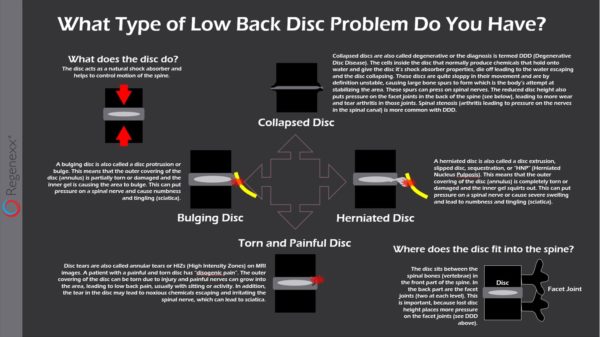How to Read a Low Back MRI Report : What Type of Disc Problem Do You Have?
I find that one of the most confusing things for patients learning how to read a low back MRI report is understanding that there are different types of disc problems that each require a different therapeutic approach. So without understanding their type of disc issue, there is no way to understand which of the newer regenerative medicine technologies may work the best.
What Is a Low Back (or Neck) Disc?
The discs are spacers in the spine that sit between the vertebra bones. They are gel filled with a tough outer covering and act as natural shock absorbers while also allowing a certain amount of motion at each level. The disc sits in the front of the spine, while the facet joints sit in the back part.
What Are the Four Types of Disc Problems?
When researching how to read a low back MRI report, most patients believe that all disc issues are the same, but nothing could be further from the truth. The four main disc injury types follow:
- Herniated
- Bulging
- Torn
- Degenerated (Collapsed Disc in the graphic above)
I’ve put together the infographic below to help you figure out which type you have. Click on the image to see a more detailed PDF.
A herniated disc is when the outer covering of the structure breaks open letting the inner gel herniate out. A bulging disc is when the outer covering doesn’t completely break open but the fibers are stretched and weak, leading the inner gel to cause bulging. A torn disc is when the outer covering gets a tear that doesn’t result in a herniation or bulge but does cause pain due to ingrown nerves or the disc leaking nasty chemicals on the associated spinal nerve. Finally a degenerated disc is one that has collapsed due to few living cells inside causing a lack of production of the chemicals that usually plump up the disc.
Which Do You Have?
A great way to figure this out is to learn how to read a low back MRI report. Here are the terms that a radiologist will use to describe each type:
- Herniated—extrusion, extruded, herniated, herniated nucleus pulposus, disc herniation, disc extrusion, free fragment, sequestered fragment, sequestered
- Bulging—protrusion, protruded, bulging, disc bulge, bulging disc, broad-based disc bulge
- Torn—annular tear, high intensity zone, HIZ, annular fissure
- Degenerated—degenerative disc disease, DDD, degenerative disc, spondylosis, decreased disc height, osteophyte(s)
Why Knowing Your Disc Injury Type Is Important for Which Regen Med Solution will Work?
These days, there are physicians who are offering to inject platelet rich plasma (PRP) or stem cells into low back discs. This is all very promising technology, but regrettably many physicians aren’t too choosy about which types of discs they treat. We’ve been injecting these things into discs since 2005 and were the first in the United States to do that work, so we’ve gotten a good sense of what works for which disc type:
- Herniated—It’s usually best to stick with a technology that doesn’t inject the disc, but instead instills isolated growth factors around the irritated nerve.
- Bulging—PRP or same-day stem cell injections into a disc have yet to demonstrate that they can get rid of disc bulges. The only technology we’ve seen reliably do that is specially cultured stem cells injected in a specific fashion (i.e., not same-day stem cells). In fact, most of these patients can be managed by the above type of epidural platelet lysate injections without ever injecting the disc itself.
- Torn—This is really the big “killer app” for stem cells and PRP disc injections. In our experience, a painful disc tear can be treated with this type of disc-injection technology.
- Degenerated—This type of disc problem doesn’t respond to any type of stem cell treatment, including specially cultured stem cells. However, in our experience it can respond to a treatment protocol focused on platelet and/or stem cell technology deployed to treat sloppy disc movement due to lax ligaments and arthritic facet joints.
The upshot? Different disc injury types need different regenerative medicine solutions. Getting up to snuff on how to read a low back MRI and then discovering which type of disc injury you have can help you find a new technology that can help you avoid surgery!

NOTE: This blog post provides general information to help the reader better understand regenerative medicine, musculoskeletal health, and related subjects. All content provided in this blog, website, or any linked materials, including text, graphics, images, patient profiles, outcomes, and information, are not intended and should not be considered or used as a substitute for medical advice, diagnosis, or treatment. Please always consult with a professional and certified healthcare provider to discuss if a treatment is right for you.

